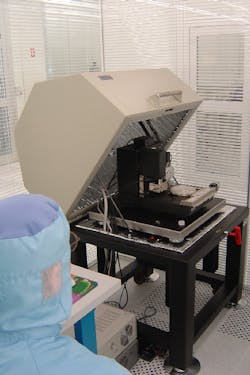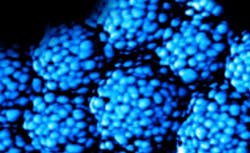Technology isn’t often the stuff of headlines, but nanotechnology certainly figures in more than its fair share these days. To give just one recent example, over the space of four days at the end of March in Germany, 97 cases of “intoxication” were reported among users of a particular bathroom sealant. Some of these were pretty severe, involving pulmonary edemas. The sealant was applied from an aerosol can in fairly enclosed spaces, suggesting some problems with the propellant material. Unfortunately, the sealant sold under the name MagicNano.
In next to no time, the product was withdrawn from the market. However, subsequent investigations into the significance of the nanoparticles contained in the sealant were somewhat hindered because of gaps in details about the formulations.
There is now some doubt whether the sealant was a product of nanotechnology after all, with the intoxication cases most likely being caused solely by the aerosol spray. Nevertheless, the initial press frenzy points up increasing public concerns about nanomaterials safety.
Safety initiatives
Proponents of the materials certainly have taken notice. For instance, German industry (including companies such as BASF, Bayer, Degussa and Solvay), universities and research institutes have just started a three-year program to develop test and measurement methods to analyze the safety of nanomaterials (CP, April, p. 17). With €5-million support from the federal government and €2.6-million from industry, the NanoCare project is to focus on ensuring that nanoparticles pose no risk to humans and the environment when used in chemical materials. “As with any new technology,” says Dr. Franz Saykowski, NanoCare project manager at Bayer, Leverkusen one of the industrial sponsors, “people have to be convinced of the benefits of nanotechnology.”
The 13 partners in the project will pool their resources to develop generally accepted test methods and use model systems to analyze the effects of new nanoparticles on health and the environment. Once the three-year study is completed, the database created will be maintained and made available to the general public via the web. “We place great value on communication with interested sections of society,” explains Saykowski.
The same laudable thinking lies behind another database set up in August 2005 by the International Council of Nanotechnology, based at Rice University, Houston, Texas. Administered by the university’s Center for Biological and Environmental Nanotechnology (CBEN), this database project stemmed from the chemical industry’s Vision 2020 Technology Partnership program. In creating a roadmap for the way in which the industry should approach the development of nanomaterials, “it became clear that determining their environmental, health and safety impact was a top priority,” says Vision 2020 chair Jack Solomon. “An informed decision about how to ensure the safety of nanomaterials requires a comprehensive review of where we are and where we’ve been with prior research.”
Given the scope of the subject, this was no easy matter and the database took three years to assemble. Kevin Ausman, CBEN’s executive director of operations, says the team at Rice transformed the database into an evolving document that would be as useful for the general public as it is for scientists. But more than that, he thinks it will be instrumental in establishing safe exposure levels and standards of care for nanomaterials.
As director of technology for the Industrial Design & Construction (IDC) division of engineering firm CH2M Hill, Portland, Ore., Mike O’Halloran has hands-on experience of designing and building nanotechnology research and production facilities (Figure 1). “In the nanoworld,” he says, “we are now beginning to be concerned about molecular level contamination. It’s leading to a rethinking of the requirements [for standardization], although they are not fully developed yet. There were some standards proposed several years ago for classifying molecular-level contaminants but they haven’t been adopted very well.”
Figure 1. CH2M Hill has been involved in project for the Danchip Nanotech Research Facility at Technical University of Denmark in Copenhagen.
Although IDC can offer widespread experience in technologies such as nanoelectromechanical systems (NEMS), microelectromechanical systems (MEMS), chemical vapor deposition (CVD), nanolithography and nanophotonics, O’Halloran acknowledges the need for a wider awareness of material properties at the nanoscale, particularly among manufacturers and researchers working with such materials. “It’s looking more likely that they need to understand what it is they might be sensitive to, so we can deal with those chemicals and materials on their own,” he says.
The semiconductor industry arguably has had a longer involvement in working at the nanoscale than most other industry sectors, but, as the information-gathering projects in the U.S. and Germany show, the chemical industry is catching on fast to nanotechnology.
Burgeoning interest
The end-user market for nanotechnology is expected to grow at an annual rate of somewhere between 10% and 15% and be worth over $600 billion by 2010, according to BASF, Ludwigshafen, Germany, and Florham Park, N.J. Industry analyst BCC International, Norwalk, Conn., forecasts a more-modest $20.5 billion as the value of the total global consumption of all types of nanomaterials by the same year (reaching 10.3-million metric tons). However, this still reflects a 9.3% projected average annual growth rate.
But whatever the size of the market — and, as with anything labeled “nanotechnology,” precise definitions can be hard to come by here (apart from the generally held view that anything involving activities at below the 100 nm, or 0.1 micron, size range can loosely be called nanotechnology) — there can be no doubting the burgeoning interest from chemical companies charged with producing nano-sized materials. BASF, for instance, in April opened its first nanotechnology research center in Asia. The company’s Competence Center for Nanostructured Surfaces in Singapore will be spending $16.4 million on research through to 2008 — but this is only a small fraction of the $227 million that BASF plans to spend on nanotechnology worldwide.
BASF is not new to nanotechnology, of course. It already markets nanomaterials such as Ultradur thermoplastic and the Col. 9 binders (Figure 2) for coatings. Among the potential products the Singapore researchers will investigate are biocide-free nanostructured coatings to tackle the problem of biofouling on marine surfaces.
Figure 2. Binders that feature a dispersion of inorganic nanoparticles in an organic polymer are now on the market.
Arkema, Paris and Philadelphia, Pa., which first launched a research and development project for the production of carbon nanotubes in 2003, also is interested in coatings. At the beginning of this year, the company inaugurated the first plant in Europe capable of producing semi-industrial amounts (around 10 metric tons per year) of the material. Located at Arkema’s Lacq Research Center in France, the plant operates a patented catalysis process designed to produce carbon nanotubes at a lower cost than those manufactured today in the laboratory. The company expects output to serve growing demand from converters in the thermoplastics, epoxy, elastomer and coatings sectors.
Producing nanomaterials like carbon nanotubes is only half the story, of course. Putting them to use is the other half — and where the money is. This certainly is the view of Air Products, Allentown, Pa., which recently announced that it is consolidating its efforts in nanotechnology. “We are focused on developing and marketing the high-value-added step of integrating nanomaterials into end-user systems by leveraging our unique dispersion technology and related know-how,” says Larry Thomas, business director for advanced materials.
To that end Air Products has bought nanoparticle-dispersion production facilities in Saarbrücken, Germany, from Nanogate Advanced Materials (NAM), its German joint venture partner. The initial products include zinc oxide, silver, and indium and antimony tin oxides in a variety of organic, aqueous and 100%-solids systems. With additional nanoparticle-dispersion production capabilities in the U.S., Air Products already is serving several markets for nanoformulated systems, such as coatings, adhesives, inks and composites.
Catalyst for change
Potentially one of the biggest application areas for metallic nanopowders and alloys is in consumer electronics. According to nanopowder producer QuantumSphere, Santa Ana, Calif., these materials could eventually replace platinum as the main catalyst in a variety of fuel cells and batteries. “The fuel cell industry and OEMs are confronted with a fundamental problem,” says the company’s CEO Kevin Maloney. “It is well-known that direct methanol fuel cells (DMFCs) should offer a clear replacement advantage for traditional battery technology. DMFCs have more energy density. They operate for far longer periods of time. But they require an excessive amount of platinum to produce the energy required to power consumer electronics and other devices that require portable power.”
QuantumSphere’s solution comes in the form of its proprietary QSI-Nano Cobalt nanomaterials, which it claims cuts the cost of DMFC catalyst materials by at least 30%. “Prior to the nano-cobalt product,” says Maloney, “the business case for a DMFC replacement solution, on a cost per watt basis, just wasn't there.”
The nano-cobalt is produced in QuantumSphere’s “bottom-up” process that combines conventional gas-phase condensation methods with the firm’s own technology. Capable of producing a wide range of nanopowders such as nickel, silver, copper and alloys, the process delivers particles with a tightly controlled particle size, uniform distribution and “custom-tailored” oxide shell thickness. There are four vapor condensation reactors in use for all the QSI products; the latest and largest one went online at the end of last year. It has production rates of between 100 kg to 200 kg/month for the likes of copper and silver, with lower rates for cobalt and nickel because of their higher boiling points. QSI-Nano is available from stock in amounts up to 500 g, and available to order in quantities above that.
Controlling the morphology of nanopowders is key to their use in catalysis, as a joint U.S./U.K. research team has found with its work on heterogeneous catalysis. Led by Graham Hutchings of Cardiff University, Cardiff, Wales, along with Chris Kiely from Lehigh University, Bethlehem, Pa., and researchers from Johnson Matthey, London and Houston, Texas, the team has found that gold nanoparticles can catalyze partial oxidations without solvents. Useful for a wide range of agrochemical and pharmaceutical syntheses, in which a key step is converting unsaturated hydrocarbons to epoxides and ketones, the carbon-supported nanoparticle clusters could replace the conventional oxidation routes involving chlorine or organic peroxides. The catalysts offer better selectivity, which can be fine-tuned by adding trace amounts of bismuth, as well as environmental benefits by potentially replacing the use of chlorine and peroxides. “The key points are that supported gold and gold/palladium alloys are very active oxidation catalysts,” Hutchings says. “They are showing great promise in green oxidations since they can be used with oxygen (rather than environmentally unsound stoichiometric oxygen donors) and without solvents under very mild conditions.”
The nanoparticles are 2 nm to 15 nm wide, and have to be distributed evenly across a large surface area. But they also have to be prevented from coalescing, as larger particles have a much weaker catalytic effect. “We’re trying to determine the size, distribution and shape of the gold nanoparticles,” says Kiely, “and see how these parameters relate to the measured catalytic properties. We’re also interested in the interaction of gold with other promoter elements such as bismuth.” Current research is focusing on selective oxidation — e.g., of hydrogen to form hydrogen peroxide and of bio-renewable feedstocks like glycerol. The emphasis at Lehigh at the moment is on catalyst preparation and characterization using X-ray photoelectron and other spectroscopic techniques. “Perhaps the leading application in the future will be hydrogen peroxide synthesis, where we have shown that gold palladium alloys are very effective for the direct oxidation of hydrogen with oxygen under safe conditions,” Hutchings says.
Gold also figures highly in a research project at Rice University’s CBEN. The work centers on improving the remediation treatment of trichloroethene (TCE), one of the most pervasive and troublesome groundwater pollutants in the country. “The advantages of palladium-based catalytic remediation of TCE are well-documented,” says lead researcher Michael Wong, assistant professor of chemical engineering and chemistry, “but so is the cost. Using nanotechnology, we were able to maximize the number of palladium atoms that come into contact with TCE molecules and improve efficiency by several orders of magnitude over bulk palladium catalysts.” The team found that in bulk palladium less than 4% of the palladium atoms were on the surface of the particle; pure palladium nanoparticles boosted that to 24%; but Pd/Au nanoparticles have 100% of the palladium atoms accessible for reaction.
Work still needs to be done to develop the proper catalyst reactor system for performing downstream remediation, says Wong, but progress is being made. “We’ve improved upon our catalyst by making smaller particles, which turn out to be more active than our ‘Version 1’ catalysts. And we’ve found that our ‘Version 2’ Pd/Au catalysts are not slowed down or poisoned by chloride ions and that they are less affected by sulfide contaminants than pure Pd catalysts,” he notes. “We can mount the Pd/Au nanoparticles onto powders that can be trapped inside a flow reactor, so we don’t lose Pd/Au nanoparticles during the reaction,” adds Wong.
Most catalysts are expensive, of course, which makes recently reported research at the Georgia Institute of Technology, Atlanta, Ga., particularly interesting. Using the special properties of new magnetic nanoparticles, researchers in the School of Chemical and Biomolecular Engineering have managed to separate for reuse two different catalysts from a multi-step chemical reaction carried out in a single vessel (Figure 3). “By doing the reactions in a single vessel, we can cut out two or three separation steps to provide both an economic advantage and an environmentally benign process,” explains Christopher Jones, associate professor. The magnetic nanoparticles work well as catalyst supports because of their size and high surface area, but because they are superparamagnetic — so small at 5 nm to 20 nm that they don’t exhibit a net magnetic attraction to each other — they remain suspended in the reaction vessel and don’t clump together until a magnetic source is brought near.
Magnetic or not, the attractions of nanotechnology are clearly booming. From his perspective as a designer and builder of nanotechnology facilities, CH2M Hill’s O’Halloran is well placed to see the whole picture. “The pace of change is unbelievable,” he says. “The tools we have developed are accelerating the pace, and as the pace accelerates, the tools get better and the pace gets faster.”





